

PM123 is a Graphical User Interface to the MP123 MPEG-audio player. This software allows you to play and control MPEG-audio Layer 1, 2 and 3 streams. It also offers extensive playlist, drag'n'drop, ID3 tag and HTTP support all wrapped nicely into a cool looking interface.
Installation
Installation procedure is very simple, all you need to do is create a directory for PM123 and unpack it there (it's recommended to use a HPFS partition, but PM123 will work just fine from a FAT partition too).[c:\os2apps] md pm123 [c:\os2apps] cd pm123 [c:\os2apps\pm123] unzip c:\pm123_b1.zipIf you want a PM123 icon on your desktop, run INSTALL.CMD.
[c:\os2apps\pm123] install
Starting the player
There are a few different ways to start PM123. You can start it simply by entering PM123 on command line or starting it from the desktop icon.
You can also start PM123 with a file (or wildcards) or a playlist as a parameter. Like this:
[c:\os2apps\pm123] pm123 c:\audio\mpeg\test.mp3 [c:\os2apps\pm123] pm123 c:\audio\mpeg\test.lst [c:\os2apps\pm123] pm123 c:\audio\mpeg\*.mp3Note: If PM123 isn't always started from its directory, you should copy MP123.DLL to a directory in your LIBPATH (or add PM123's directory to your LIBPATH).
Playing your first file
When you have started the player, you'll get the player window on your desktop.
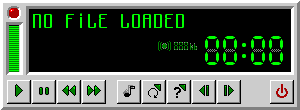
Next click on the player window with right mouse button (RMB from here on). You should get a menu like this:
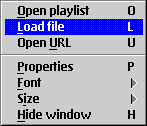
Click on Properties.
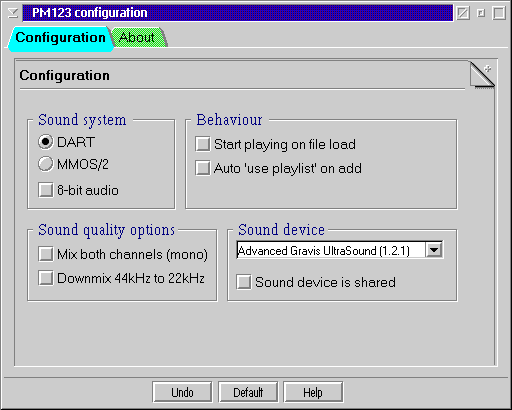
You can now configure the player. For information about configuring, look at Configuring PM123.
Pop up the menu with RMB again, and click on Load file. Then select a file to load and click Ok.
Now you have loaded a file.
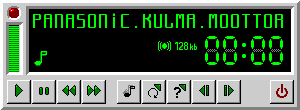
Click on play and enjoy the music!

Controlling your player
PM123 can be controlled with the buttons in the main window.


Play and stop 
Pause 
Rewind and fast forward 
Opens and closes the playlist window 
Toggles the repeat of playlist 
Toggles the shuffle (random play) of playlist 
Skips to previous or next song in playlist 
Quits PM123 Additional options can be access by click right mouse button on the main window. It pop ups this menu:

Open playlist: Opens the playlist window.
Load file: Loads a single file to the player.
Open URL: Opens a file directly from the Internet (or Intranet) using the HTTP protocol. It only accepts URLs prefixed with http://.
Properties: Brings up a notebook for PM123 settings.
Font: PM123 has two different fonts for the main screen. You can select between them.
Size: You can choose between different play window looks. Small and tiny are for people who don't want PM123 to take any extra desktop space.
Hide window: Hides PM123 window. You can restore PM123 window from the Window list.
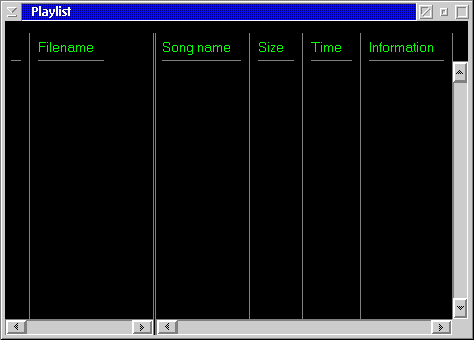
You can manage the playlist by clicking to it with right mouse button on a empty space (space where there are no filenames). It should bring up this menu:
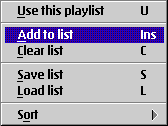
Use this playlist: By default PM123 is in a "single file play" mode. You must first select Use this playlist to activate the playlist.
Add to list: Prompts you for files to add in the playlist. NOTE! You can also add playlists.
Clear list: Clears the whole list.
Save list: Saves the list into a .LST-file.
Load list: Loads a list into the playlist (replacing your current list).
Sort: You can sort the playlist by file size, playing time, filename and song name.
If you click on a filename on the playlist, you'll get this menu:

Play: Plays this file.
Remove from list: Removes this file from the playlist.
Edit tag: Edits this files ID3 tag information. For more information, see ID3 tags.
You can organize the files in playlist by grabbing a file with right mouse button and dragging it to a new location in the playlist.

This is the Properties notebook. It can be accessed by RMB'ing the main window and selecting Properties. It has two pages, Configuration and About.
Sound system
DART: Uses the DART sound system in OS/2. It should work with an out-of-the-box Warp 4 or Warp 3 with the DART DLLs (available from hobbes.nmsu.edu).
MMOS/2: Uses the basic MMOS/2 for sound. Sometimes works more reliably than DART. Might be even faster on some systems. Select the sound system which suits best for you.
8-bit audio: Plays the music with 8 bits instead of 16 bits. Use this if you have an old 8-bit sound card.
Behaviour
Start playing on file load: Starts playing automatically when you drop a file or load a file from PM123.
Auto 'use playlist' on add: Automatically uses the playlist when you add files to it.
Sound quality
Mix both channels (mono): Mixes the left and right channel into one channel and uses mono playback. Drops the CPU usage dramatically. Good for 486DX100 or Pentium-75 owners.
Downmix 44kHz to 22kHz: Decodes only every second sample and plays the song at 22kHz. Combined with mono mode you can play Layer 3 streams on a 486DX2!
Sound device
Select the sound device to use for playback from the drop down list.
Sound device is shared: Opens the sound device in shared mode. It means that if your driver supports it, you can, for example, listen to a MPEG-audio stream and hear system sounds at the same time! Not many drivers support this (at least Gravis Ultrasound "Next Generation" drivers support this).
ID3 tags is a method of storing song information inside a MPEG-audio stream. The information resides at the end of the song. You can browse thru a files information by clicking on the file name in the main window.
PM123 comes with a built-in ID3 tag editor (accessed from the playlist window).
- Drag'n'drop: You can practically drop anything over the main window and playlist. Try dropping MPEG-audio files or playlists on the main window or the playlist (or a color from the System Palette).
- Main window filename: Click on it to browse ID3 tag entries.
Authors, reporting bugs, obtaining latest version, etc.
Authors
Original MPEG-audio decoder was done by Michael Hipp, the OS/2 port of the decoder (mp123 and mp123.dll) was done by Samuel Audet (www) and the GUI (Graphical User Interface) for OS/2 PM was done by Taneli Leppä (www).
Bug reporting
If you think you've found a bug or a problem inside the program, please FIRST check the list of known bugs. If your bug isn't mentioned there, then you can use this bug report form.
Obtaining the latest version
Latest version can be found from the PM123 home page (mirror). New betas are also uploaded to hobbes.nmsu.edu and ftp.leo.org.